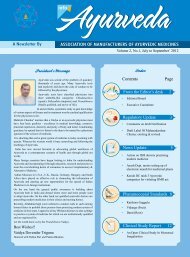Issue 12 - amam-ayurveda.org
Issue 12 - amam-ayurveda.org
Issue 12 - amam-ayurveda.org
You also want an ePaper? Increase the reach of your titles
YUMPU automatically turns print PDFs into web optimized ePapers that Google loves.
President’s Message<br />
May your Baisakhi be blessed<br />
with bounty of the season<br />
and a harvest of joy and<br />
prosperity<br />
Best Wishes!!<br />
Vaidya Devender Triguna<br />
Honored with Padma Shri and Padma Bhushan<br />
Volume 1, No.<strong>12</strong>, April –June’ 20<strong>12</strong><br />
Index<br />
Contents Page<br />
From the Editor’s desk 2<br />
• Editorial Board<br />
• Executive Committee<br />
News Update 3<br />
• Union govt. draws up roadmap to<br />
promote ISM through NRHM<br />
• European Pharmacopoeia commences<br />
development of ‘Community<br />
Monographs’ for herbal remedies<br />
Pharamocopial Standards 5<br />
• Pushyanuga Churan<br />
• Patha<br />
• Jambu<br />
• Amra<br />
• Pashanbheda<br />
• Ativisha<br />
• Indrayava<br />
Clinical Study Report 11<br />
• Basant Kusmakar Ras<br />
Upcoming Events 15
Dear Members,<br />
From the Editor’s desk<br />
Ayurvedic medicines have been in use since ages. But today the whole<br />
world is looking at it, especially as a remedy for lifestyle ailments.<br />
Lot of research work has been done on ayurvedic herbs since its<br />
inception. Therefore there emerged a need for compilation of entire<br />
scientific development done so far post to the classical period.<br />
Realizing this need gap, a thought emerged and all the important work<br />
was compiled into a book form by Shri CP Khare and Dr. C K Katiyar<br />
along with Dr. VK Agrawal and Dr. Arun Gupta who aptly named<br />
the book as The Modern Ayurveda: Milestones Beyond the Classical<br />
Age. Mr. VC Burman (former chairman of Dabur India Limited) was<br />
the major inspiring factor behind conceptualizing this book. This<br />
book contains several topics that are essential to understand the surge<br />
of scientific work that is now being conducted on this age old system<br />
of medicine.<br />
The book enumerates more than 400 Ayurvedic herbs in a user friendly<br />
tabulated format including their botanical name, common Ayurvedic<br />
name, its family, chemical constituents, phytochemical markers,<br />
pharmacological actions, with their interactions and toxicity.<br />
For the evaluation of safety and efficacy of herbal medicine, this<br />
book explores current research methodologies adopted and makes us<br />
aware of the contemporary international regulatory status of herbal<br />
drugs in overseas.<br />
Today, a lot of universities have started academic courses; however<br />
there were no text books on Ayurveda containing chemical and<br />
pharmacological actions on herbs.<br />
Besides providing safety evaluation for the first time a book has been<br />
published by Francis and Taylor to fill the need gap.<br />
The writers of this book Mr. CP Khare has written many books on<br />
Indian medicinal herbs and Dr. C K Katiyar who is well known<br />
expert in ayurvedic research has published several research papers<br />
to his credit. This book is useful for students of Ayurveda in India<br />
and worldwide. The book will be equally helpful to researchers and<br />
academicians of Ayurveda.<br />
Dr. Manju Rakesh<br />
On behalf of full editorial board<br />
Disclaimer: Articles in the newsletter are written by independent individuals. News Clips of Upcoming<br />
Events, Govt. Notifications, Schemes have been taken from different sources. Their opinions do not<br />
necessarily reflect those of Info Ayurveda. They are put here for interest and reference only. None of the<br />
contributors, sponsors, administrators, or anyone else connected with Info Ayurveda in any way whatsoever<br />
shall be responsible for the appearance of any inaccurate information or for your use of the information<br />
contained in the newsletter.<br />
info Ayurveda, Volume 1, No.<strong>12</strong>, April-June’ 20<strong>12</strong><br />
Patron<br />
Members of AMAM’s Management<br />
Committee<br />
Vaidya Brahaspati Dev Triguna<br />
Suresh Sharma<br />
Pradip Burman<br />
President<br />
Vaidya Devender Triguna<br />
Tel: 011-24354141<br />
Vice President<br />
Anurag Sharma<br />
Shri Baidyanath Ayurved Bhawan<br />
Ltd., (Jhansi)<br />
E-mail: anurag@baidyanathayurved.com<br />
Asad Mueed<br />
Hamdard (WAKF) Laboratories<br />
E-mail: amueed@hamdardindia.com<br />
Devendra Garg<br />
Dabur India Limited<br />
E-mail: gargd@dabur.com<br />
Ravi Prasad<br />
The Himalaya Drug Co.<br />
E-mail: ravi.prasad@himalayahealthcare.com<br />
Hon. Gen. Secretary<br />
Pradeep Multani<br />
Multani Pharmaceuticals Ltd.<br />
e-mail: chairman@multaniayurved.<strong>org</strong><br />
Treasurer<br />
Tejinder Singh<br />
Dabur India Limited<br />
e-mail: singht@dabur.com<br />
Jt. Secretary<br />
Ajay Sharma<br />
Shri Baidyanath Ayurved Bhawan,<br />
New Delhi<br />
E-mail: ajdelhi@msn.com<br />
Arun Chauhan<br />
BACFO Pharmaceuticals (India) Ltd.<br />
E-mail: chauhanarun@akcgroup.com<br />
Dr. N.B. Brindavanam<br />
Dabur India Limited<br />
E-mail: baba@dabur.com<br />
M. J. Saxena<br />
Sanat Laboratories Ltd.<br />
E-mail: mjsaxena@anatproducts.co.in<br />
Members<br />
Vijay Grover<br />
Kamal Pharmacy, New Delhi<br />
E-mail: vijay@kamalpharmacy.com<br />
Pramod Sharma<br />
Shri Baidyanath Ayurved Bhawan<br />
Ltd. Patna<br />
E-mail: pramodsharma54@yahoo.com<br />
Dr. Manju Rakesh<br />
Dabur India Limited<br />
E-mail: rakeshm@dabur.com<br />
Amit Agarwal<br />
Natural Remedies<br />
E-mail: amit@naturalremedies.com<br />
Dr. Anantha Narayana D B,<br />
Ph.D., Consultant<br />
Email: dba.narayana@gmail.com<br />
Editorial Board:<br />
Chief Editor:<br />
Mr. Pradeep Multani<br />
Honorary General Secretary AMAM<br />
Chairman Multani Pharmaceutical Limited<br />
36-H Connaught place, New Delhi- 1<br />
Editor:<br />
Dr. Manju Rakesh<br />
Dabur India Limited, Plot No. 22, Site IV,<br />
Sahibabad - 201010, Ghaziabad (U.P.)<br />
Mr. Anurag Sharma, Executive Director<br />
Shri Baidyanath Ayurved Bhawan Pvt. Ltd. (Jhansi)<br />
B- 6/5, Safdarjung Enclave, New Delhi<br />
Mr. Asad Mueed, Director<br />
Hamdard (WAKF) Laboratories, Asaf Ali Road, New Delhi – 2<br />
Mr. Ajay Sharma, President<br />
Shri Baidyanath Ayurved Bhawan, Naini,<br />
28, Ishwar Nagar East, New Delhi – 65<br />
A Publication of:<br />
Association of Manufacturers of Ayurvedic Medicines<br />
Regd. Office: 22, Site –IV, Sahibabad,<br />
Ghaziabad - 201010 (UP), Tel: 0<strong>12</strong>0 4378400, Fax: 0<strong>12</strong>0 4376909<br />
Correspondence Address: H-36, Connaught Place, New Delhi-110001,<br />
Tel: 011-23350062, Fax: 011-23350063<br />
E-mail : <strong>amam</strong>india@gmail.com website: www.<strong>amam</strong>-<strong>ayurveda</strong>.<strong>org</strong><br />
2
Nandita Vijay, Bengaluru, Thursday, February 16, 20<strong>12</strong>, 08:00 Hrs [IST]<br />
The central government has drawn up an ambitious<br />
roadmap to promote Indian Systems of Medicine<br />
(ISM) like Ayurveda, Siddha, Unani, and therapies such<br />
as yoga and naturopathy through the National Rural<br />
Health Mission (NRHM).<br />
With yoga and naturopathy gaining worldwide<br />
acceptance, the government is now gearing up to address<br />
health issues across the population through these systems<br />
of medicine, stated S Gandhiselvan, minister of state for<br />
health and family welfare.<br />
“It is a foregone conclusion that yoga and naturopathy<br />
can prevent and cure various forms of ailments. In the last<br />
three decades, Yoga, in particular, has become popular<br />
all over the world as an effective disease management<br />
strategy. The government has decided to give special<br />
impetus to Yoga and Naturopathy so that the objectives<br />
of NRHM are met through the ISM,” he stated at the<br />
‘Arogya Expo 20<strong>12</strong>’ and the ‘International Conference<br />
on Yoga and Naturopathy’ (ICYN) Bengaluru held here<br />
from February 9-13.<br />
The broad policy support extended to the development<br />
of Ayush systems of medicine has ensured the <strong>org</strong>anized<br />
development of all these six systems of healthcare based<br />
on their individual merits and strengths.<br />
The launch of NRHM has been significant for Ayush<br />
systems, as one of its objectives was to promote the<br />
effective provision of the healthcare to the masses.<br />
info Ayurveda, Volume 1, No.<strong>12</strong>, April-June’ 20<strong>12</strong><br />
News update<br />
Union govt. draws up roadmap to promote<br />
ISM through NRHM<br />
Under NRHM, AYUSH doctors and facilities are being<br />
introduced in primary health centres and community<br />
health centres throughout the country. The availability<br />
of AYUSH facilities in PHCs and CHCs would ensure<br />
that the entire range of medical facilities would be<br />
available to the public and to the poor in particular. The<br />
main streaming of AYUSH in the healthcare system<br />
will have a significant impact on the health status of the<br />
people, stated the minister.<br />
“The NRHM is significant for ISM, as it is capable of<br />
meeting the objectives of India’s health requirements.<br />
The government intends to introduce ISM at the primary<br />
health centres and community health centres all over<br />
the country shortly. Yoga and naturopathy have been<br />
accepted for effective disease management because of<br />
their unique and holistic healing approaches. It is time<br />
we also took advantages of the same by introducing them<br />
through public health system,” the minister added.<br />
He pointed out that there were 6 lakh practitioners of<br />
ISM and homoeopathy in the country. However, that<br />
number was still insufficient to address the health issues<br />
plaguing the country.<br />
“The government is evolving a broad policy to promote<br />
ISM and Ayush colleges. At present, there are 488 Ayush<br />
colleges in the country. But the quality of education<br />
is a concern. We will make suitable suggestions after<br />
consulting experts in the field to improve the quality of<br />
education,” he explained.<br />
Courtesy : PHARMABIZ.com<br />
3
Nandita Vijay, Bengaluru, Friday, December 30, 2011, 08:00 Hrs [IST]<br />
info Ayurveda, Volume 1, No.<strong>12</strong>, April-June’ 20<strong>12</strong><br />
European Pharmacopoeia commences<br />
development of ‘Community Monographs’ for<br />
European Pharmacopoeia and the European Medicine<br />
Agency have commenced the preparation of<br />
‘Community Monographs’ for herbal remedies. To begin<br />
with, the monographs will be made applicable for single<br />
herbs.<br />
The decision to create monographs is driven by<br />
the increasing shift in consumers opting for dietary<br />
supplements and nutraceuticals developed from herbs.<br />
The development of pharmacopoeia monographs would<br />
provide the much-needed information, stated Dr D B<br />
Anantha Narayana, leading scientist in herbal drugs and<br />
plant medicine.<br />
Even the government of India through the Indian<br />
Pharmacopoeia or Ayurveda Pharmacopoeia needs to<br />
take up this. It would be the best way to ensure India gets<br />
its prominent position in the global herbal map. In an age<br />
of growing consumption of herbal nutraceuticals, there<br />
is need for authentic information on products, its usage,<br />
quality, dosage forms and disease indications, he added.<br />
Pharmacopoeia monographs would serve not just for<br />
consumers but is important for physicians and pharmacists.<br />
US Pharmacopoeia (USP) is now primarily a regulatory<br />
quality specifications for all categories of drugs which<br />
can be extended to cover the ‘Dietary Supplements’.<br />
Although, mere presence of a herb in a Pharmacopoeia<br />
does not mean it is approved as a drug, yet its importance<br />
cannot be underestimated. Pharmacopoeia monographs<br />
provide a reference globally for quality specifications<br />
for the authentic identity, content, component quality. It<br />
is an assurance that the product sans contaminants like<br />
microbial, pesticides and heavy metals. The very mention<br />
of a herb in the pharmacopoeia monograph allows easy<br />
trade and reduces rejections in the global market. It is<br />
herbal remedies<br />
also an indication to ensure batch-to-batch consistency<br />
for researchers. While the herb with a monograph can<br />
promote future technology developments, it provides<br />
regulators a confidence on the history of usage and safety<br />
profiles in the large scale production of a product, said Dr<br />
Narayana.<br />
Globally, in the area of traditional knowledge based<br />
treatments, over 90 per cent of the products are botanical<br />
based. Despite the considerable discussions on need for<br />
standardization for herbal products, there has been a rise<br />
of use in herbal botanicals as supplements which do not<br />
come under the category of drugs. But the Pharmacopoeia<br />
experience coming handy has been largely to access the<br />
specifications of the herbs.<br />
Indian Pharmacopoeia 2010 [IP2010] has 89 monographs<br />
for herbs, processed herbs, including for extracts/oils, and<br />
herbal products. USP has over 180 monographs for herbs,<br />
powdered herbs, processed herbs including extracts, oils,<br />
and herbal products. British Pharmacopoeia (BP) has over<br />
50 monographs for herbs, powdered herbs, processed<br />
herbs including extracts, oils, and herbal products.<br />
European Pharmacopoeia (EP) has over 60 monographs<br />
for herbs, powdered herbs, processed herbs including<br />
extracts, oils, and herbal products. Pharmacopoeia of<br />
Republic of China [PRC] has over 180 monographs<br />
for herbs, powdered herbs, processed herbs including<br />
extracts, oils, and herbal products besides being the<br />
one that has quality specifications for large number of<br />
Traditional Chinese medicines (poly herbal).<br />
With international regulators insisting now insisting on<br />
authentic herbs with defined botanical identity India<br />
will need to look at building a ‘Minimum Therapeutic<br />
Guarantee’ basis and establish a natural window of few<br />
compounds and test for the compliance to the window,<br />
pointed out Dr Narayana.<br />
Courtesy: PHARMABIZ.com<br />
4
Pharmocopial Standards For Ayurvedic Formulations<br />
and Raw Materials<br />
PUSHYANUGA CHURNA<br />
(AFI PART – I, PG. 91-92.)<br />
ikBktECo;kseZ?;a f”kykHksna jlk¥tue~A<br />
vEc’Bdh ekspjl% leM~xk ineds”kje~AA46AA<br />
dV~Qya efjpa “kq.Bh e`}hdk jäpUnueAA47AA<br />
dV~oM~xoRldkuUrk /kkrdh e/kqdktZque~A<br />
iq’;s.kksÌR; rqY;kkfu “y{.kpw.kkZfu dkj;sr~AA48AA<br />
rkfu {kkSnzs.k la;ksT; ik;s;sÙk.M`ykEcqukA<br />
vl`Xnjkfrlkjs’kq jäa ;Ppksios”;rsAA49AA<br />
nks”kkxUrqd`rk ;s p ckykuka rka”p uk”k;sr~A<br />
;ksfunks’ka jtksnks’ka Üosra uhya lihrde~AA50AA<br />
L=h.kka “;kok:.k ;Pp rRizlã fuoÙkZ;srA<br />
pw.kZa iq’;kuqxa uke fgrek=s;iwftre~A<br />
vEc’Bk nf{k.ks [;krk x`à.kUr;U;s rq y{e.kke~AA51AA<br />
¼HkS’kT;jRukoyh] L=hjksxkf/kdj] 46&51½<br />
1. Patha (Rt.) 1 Part<br />
2. Jambu (beeja majja) (Enm.) 1 Part<br />
3. Amra (beeja majja) (Enm.) 1 Part<br />
4. Shilabheda (Pashanabheda) (Rz.) 1 Part<br />
5. Rasanjana (Daruharidra) (St.Ext.) 1 Part<br />
6. Ambashthaki (patha) (Rt.) 1 Part<br />
7. Mocarasa (Exd.) 1 Part<br />
8. Samanga (Manjishtha) (Rt./Pl.) 1 Part<br />
9. Padma kesara (Adr.) 1 Part<br />
10. Vahika (Kumkuma) (Stl./Stg) 1 Part<br />
11. Ativisha (Rt.Tr.) 1 Part<br />
<strong>12</strong>. Musta (Rz.) 1 Part<br />
13. Bilva (St.Bk.) 1 Part<br />
14. Lodhra (St.Bk.) 1 Part<br />
15. Gairika 1 Part<br />
16. Katphala St.Bk.) 1 Part<br />
17. Marica (Fr.) 1 Part<br />
18. Shunthi (Rz.) 1 Part<br />
19. Mridvika (Dr.Fr.) 1 Part<br />
20. Rakta candana (Ht.Wd.) 1 Part<br />
21. Katvanga (Araluka) (St.Bk. 1 Part<br />
22. Vatsaka (Kutaja) (St.Bk.) 1 Part<br />
23. Ananta (Rt.) 1 Part<br />
24. Dhataki (Fl.) 1 Part<br />
25. Madhuka (Yashti) (Rt.) 1 Part<br />
26. Arjuna (St.Bk.) 1 Part<br />
info Ayurveda, Volume 1, No.<strong>12</strong>, April-June’ 20<strong>12</strong><br />
Dose: 1 to 3 g<br />
Anupana: Honey and Tandulodaka<br />
Important Therapeutic Uses: Asrigdara, Shveta Pradara, Rajodosha<br />
PATHA (Root)<br />
(API Part –I, Vol. 1, Pg.92)<br />
Patha consists of roots of Cissampelos pareira Linn. (Fam.<br />
Menisperrnaceae), an extensively spreading, glabrous to softy pubescent,<br />
perennial climbing shrub with nodose stem, common in warm and dry<br />
regions of tropical and sub-tropical parts of India upto an altitude of about<br />
1500 m.<br />
SYNONYMS<br />
Sanskrit : Ambashthaki<br />
Assamese : Tuprilata<br />
Bengali : Patha, Akanadi<br />
English : Velvet leaf<br />
Gujrati : Venivel, Karedhium Kalipath, Karondhium, Karondium,<br />
Hindi : Patha, Padh, Akanadi<br />
Kannada : Pahadavela, Agalushunthi<br />
Kashmiri : Pad<br />
Malayalam : Patha<br />
Marathi : Pashadvel, Paharrel, Pahadavel, Padali<br />
Oriya : Kanabindhi, Patha<br />
Punjabi : Patha<br />
Tamil : Vatta tiruppi<br />
Telugu : Adivibankatiga, chiru boddi, Boddi tiga<br />
DESCRIPTION<br />
a) Macroscopic<br />
Roots, cylindrical, often tortuous, 1-1.5 cm in diameter, light brown to<br />
yellowish in colour, surface rough and at places rugged due to transverse<br />
wrinkles, cracks and fissures, fracture short and splintery, odour, faint<br />
aromatic, taste, bitter.<br />
b) Microscopic<br />
Transverse section of root shows, 6-10 layers of thin-walled, rectangular<br />
cork cells secondary cortex, 1-3 layered of oval to tangentially elongated<br />
5
cells, discontinuous ring consisting of 2-3 rows of stone cells and group<br />
of phloem fibres, stone cells variable in shape with simple pits, vascular<br />
strands as radiating strips usually 8-<strong>12</strong> of xylem and phloem some reaching<br />
up to the centre, phloem consists of small strands of sieve elements and<br />
parenchyma just below the ring of stone cells, xylem consists of vessels,<br />
tracheids, fibres and xylem parenchyma, vessels and tracheids show simple<br />
pits on the walls, xylem parenchyma usually thick-walled and lignified<br />
but due to delignification patches of thin-walled parenchyma appear in<br />
the xylem region., medullary rays 1-3 seriate appear to be very wide at<br />
a number of places due to addition of delignified xylem parenchymatous<br />
cells, ray cells thin-walled, a few lignified and thick-walled while some<br />
show reticulate thickening, plenty of starch grains present in some of ray<br />
cells.<br />
Powder – Greyish-brown; under microscope shows group of cells, fibres<br />
and starch grains; crystals absent.<br />
IDENTITY, PURITY AND STRENGTH<br />
Foreign matter: Not more than 2 per cent,<br />
Total Ash: Not more than 7 per cent,<br />
Acid-insoluble ash: Not more than 1 per cent,<br />
Alcohol-soluble extractive: Not less than 11 per cent,<br />
Water-soluble extractive: Not less than 13 per cent,<br />
CONSTITUENTS - Alkaloids, saponin and quarternary ammonium<br />
bases, flavonol and sterol.<br />
PROPERTIES AND ACTION<br />
Rasa : Tikta, Katu<br />
Guna : Laghu, Tikshna<br />
Virya : Ushna<br />
Vipaka : Katu<br />
Karma : Tridoshashamana, Raktashodhaka, Vishaghna, Bhagnasand-<br />
hanakrit, Grahi, Stanyashodhana<br />
IMPORTANT FORMULATIONS - Pushyanuga Churna, Pradarantaka<br />
Lauha, Sarasvata Ghrita, Brihat Gangadhara Churna, Stanyashodhana<br />
Kashaya Churna<br />
THERAPEUTIC USES - Shularoga, Atisara, Kushtha, Kandu, Jvara,<br />
Chardi, Stanyadushti<br />
DOSE - 3-6 g of the drug in powder form.<br />
JAMBU (Seed)<br />
(API Part –I, Vol. II, Pg.54)<br />
Jambu consists of dried seeds of Syzygium cuminii (Linn.) Skeels Syn.<br />
Eugenia jambolana Lam.; E. cuminii Druce. (Fam. Myrtaceae); a large<br />
info Ayurveda, Volume 1, No.<strong>12</strong>, April-June’ 20<strong>12</strong><br />
evergreen tree, attaining a height of 30 m and a girth of 3.6 m with a bole<br />
up to 15 m, found throughout India upto an altitude of 1,800 m.<br />
SYNONYMS<br />
Bengali : Badjam, Kalajam<br />
English : Jambul tree<br />
Gujrati : Gambu, Jamun<br />
Hindi : Jamuna<br />
Kannada : Nerale Beeja, Jambu Nerale<br />
Malayalam : Njaval<br />
Marathi : Jambul<br />
Oriya : Jam Kol, Jamu Kol<br />
Punjabi : Jaamun<br />
Tamil : Naval<br />
Telugu : Alla Nereduchettu, Neredu chettu<br />
Urdu : Jamun<br />
DESCRIPTION<br />
a) Macroscopic:<br />
2-5 seeds, compressed together into a mass resembling a single seed,<br />
the whole seed enclosed in a cream coloured, coriaceous covering,<br />
smooth, oval or roundish, 1 cm long, 1 cm wide, brownish-black; taste,<br />
astringent.<br />
b) Microscopic<br />
Seed - Shows cotyledons consisting of single layered epidermis, mesophyll<br />
composed of isodiametric, thin-walled, parenchymatous cells fully packed<br />
with simple starch grains, oval, rounded measuring 7-28 μ in dia., a few<br />
schizogenous cavities are also found.<br />
Powder - Brown coloured; shows a few parenchymatous cells and<br />
numerous oval, rounded starch grains, measuring 7-28 μ in diameter.<br />
IDENTITY, PURITY AND STRENGTH<br />
Foreign matter: Not more than 1 per cent,<br />
Total Ash: Not more than 5 per cent,<br />
Acid-insoluble ash: Not more than 1 per cent,<br />
Alcohol-soluble extractive: Not less than 6 per cent,<br />
Water-soluble extractive: Not less than 15 per cent.<br />
T.L.C.<br />
T.L.C. of alcoholic extract of the drug on Silica gel ‘G’ plate using<br />
Toluene:Ethylaceate<br />
(90: 10) shows under U.V. light (366 nm) one fluorescent zone at Rf.<br />
0.30 (blue). On exposure to Iodine vapour four spots appear at Rf. 0.<strong>12</strong>,<br />
0.20, 0.30 and 0.95 (all yellow). On spraying with Vanillin-Sulphuric acid<br />
reagent and heating the plate for ten minutes at 105°C, three spots appear<br />
at Rf. 0.20, 0.30 and 0.95 and 0.95 (all violet).<br />
CONSTITUENTS<br />
Glycoside (Jamboline), Tannin, Ellagic acid and Gallic acid.<br />
PROPERTIES AND ACTION<br />
Rasa : Madhura, Amla, Kashaya<br />
Guna : Guru, Ruksha<br />
Virya : Shita<br />
Vipaka : Katu<br />
Karma : Vatala, Pittahara, Kaphahara, Vishtambhi, Grahi<br />
IMPORTANT FORMULATIONS – Pushyanuga Churan<br />
THERAPEUTIC USES - Madhumeha, Udakameha<br />
DOSE - 3-6 g of the drug in powder form.<br />
6
AMRA (Seed)<br />
(API Part –I, Vol. III, Pg.7)<br />
Amra consists of dried seed of Mangifera indica Linn. (Fam.<br />
Anacardiaceae), a tree found wild or cultivated throughout the country.<br />
SYNONYMS<br />
Sanskrit : Amrabijamajja<br />
Bengali : Am<br />
English : Mango<br />
Gujrati : Aambaro, Ambanoo, Aambo, Keri<br />
Hindi : Aam<br />
Kannada : Amavina<br />
Malayalam : Manga<br />
Marathi : Aamba<br />
Oriya : Amkoili, Ambakoiti<br />
Tamil : Mangottai Paruppu, Maangottai<br />
Telugu : Mamidi-Jeedi<br />
Urdu : Aam<br />
DESCRIPTION<br />
a) Macroscopic<br />
Seed 3-4.5 cm long, 1.5-2.5 cm wide, ovoid, oblong covered with<br />
wrinkled integument, both outer and inner integument closely united,<br />
outer integument buff coloured, inner integument reddish-brown; taste,<br />
bitter and astringent.<br />
b) Microscopic<br />
Seed shows outer integument consisting of tangentially elongated, irregular,<br />
thin walled, parenchymatous cells, with poorly developed conducting<br />
tissues of vessels showing spiral thickenings towards inner integument,<br />
inner integument consisting of slightly rectangular, wavy and large thinwalled<br />
parenchymatous cells; cotyledons 2, composed of isodiametric,<br />
parenchymatous cells fully packed with simple and compound starch<br />
grains; compound starch grains consisting of 2-6 components, each<br />
starch grain round to oval, measuring 2-28 μ in dia., a few conducting<br />
tissues with spiral vessels also found scattered in parenchymatous cells<br />
of cotyledons.<br />
Powder - Greyish-buff; shows reddish-orange coloured cells of integument,<br />
thin-walled, parenchymatous cells, simple and compound starch grains,<br />
consisting of 2-6 components, measuring 2-28 μ in diameter.<br />
IDENTITY, PURITY AND STRENGTH<br />
Foreign matter: Not more than 1 per cent,<br />
Total Ash: Not more than 3 per cent,<br />
Acid-insoluble ash: Not more than 0.5 per cent,<br />
Alcohol-soluble extractive: Not less than 10 per cent,<br />
Water-soluble extractive: Not less than 10 per cent,<br />
T.L.C.-<br />
T.L.C. of the alcoholic extract on Silica gel ‘G’ plate using n-Butanol :<br />
Acetic acid: Water (4:1:5) shows under U.V. (366 nm) two fluorescent<br />
info Ayurveda, Volume 1, No.<strong>12</strong>, April-June’ 20<strong>12</strong><br />
zones at Rf. 0.62 (yellowish) and 0.92 (blue). On exposure to Iodine<br />
vapour five spots appear at Rf. 0.07, 0.29, 0.62, 0.77 and 0.93 (all yellow).<br />
On spraying with 5% Methanolic-Sulphuric acid reagent and heating the<br />
plate for about ten minutes at 110°C five spots appear at Rf. 0.07 (grey),<br />
0.29 (grey), 0.62 (grey), 0.77 (brown) and 0.93 (brown).<br />
CONSTITUENTS - Tannins - Pyrogallotannins<br />
PROPERTIES AND ACTION<br />
Rasa: Kashaya, Madhura<br />
Guna: Ruksha<br />
Virya: Shita<br />
Vipaka: Katu<br />
Karma : Samgrahi, Vatakara, Krimighna<br />
IMPORTANT FORMULATIONS - Pushyanuga Churna, Brihat<br />
Gangadhara Churna, Ashokarishta<br />
THERAPEUTIC USES - Atisara, Pravahika, Chardi, Daha, Tvagroga<br />
DOSE - 1-2 g of the drug in powder form<br />
PASHANABHEDA (Rhizome)<br />
(API Part –I, Vol. I, Pg.90)<br />
Pashanabheda consists of rhizomes of Bergenia ciliata (Haw.) Sternb.,<br />
Syn. Bergenia ligulata (Wall.) Engl. (Fam. Saxifragaceae), a small<br />
perennial herb found throughout temperate Himalayas from Bhutan to<br />
Kashmir at an altitude between 2000-3000 m and in Khasia hills upto<br />
<strong>12</strong>00 m altitude.<br />
SYNONYMS<br />
Sanskrit: Ashmabhedaka, Shilabheda<br />
Assamese: Patharkuchi<br />
Bengali: Patharkuchi, Himasagara, Patrankur<br />
Gujrati: Pashanbheda, Pakhanbheda<br />
Hindi: Pakhanabheda, Silphara, Patharcua, Pakhanabhed, Silpbheda<br />
Kannada: Alepgaya, Pahanbhedi, Hittaga, Pasanaberu, Hittulaka<br />
Kashmiri : Pashanbhed<br />
Malayalam : Kallurvanchi, Kallurvanni, Kallorvanchi<br />
Marathi : Pashanbheda<br />
Oriya : Pasanbhedi, Pashanabheda<br />
Punjabi : Kachalu, Pashanbhed<br />
Tamil : Sirupilai<br />
Telugu : Kondapindi<br />
DESCRIPTION<br />
a) Macroscopic<br />
Rhizome, solid, barrel shaped, cylindrical, 1.5-3 cm long and 1-2 cm<br />
in diameter with small roots, ridges, furrows and root scars distinct,<br />
tranversely cut surface shows outer ring of brown coloured cork, short<br />
middle cortex, vascular bundles and large central pith, odour, aromatic,<br />
taste, astringent.<br />
7
) Microscopic<br />
Transverse section of rhizome shows cork divided into two zones, outer<br />
a few layers of slightly compressed and brown coloured cells, inner<br />
zone multilayered consisting of thin-walled tangentially elongatd and<br />
colourless cells, followed by a single layered cork cambium and 2-3 layers<br />
of secondary cortex composed of thick-walled, tangentially elongated,<br />
rectangular cells with intercellular spaces, some cells contain<br />
rosette crystals of calcium oxalate and simple starch grains cortex a narrowzone<br />
of parenchymatous cells containing a number of simple starch grains,<br />
most of cortical cells also contain large rosette crystals of calcium oxalate,<br />
endoderm is and pericycle absent. vascular bundles, arranged in a ring,<br />
collateral, conjoint and open, phloem tissues cornposed of sieve elements<br />
and parenchyma, in outer region found as compressed masses while in<br />
inner region intact. a number of rosette crystals of calcium oxalate also<br />
found as crystal fibres, cambium present as continuous ring composed of<br />
2-3 layers of thin walled, tangentially elongated cells, xylem consist of<br />
fibres, tracheids, vessels and parenchyma, with centre occupied by large<br />
pith composed of circular to oval, parenchymatous cells, varying in size<br />
and containing starch grains with crystals of calcium oxalate similar to<br />
those found in cortical region.<br />
IDENTITY, PURITY AND STRENGTH<br />
Foreign matter: Not more than 2 per cent,<br />
Total Ash: Not more than 13 per cent,<br />
Acid-insoluble ash: Not more than 0.5 per cent,<br />
Alcohol-soluble extractive: Not less than 9 per cent,<br />
Water-soluble extractive: Not less than 15 per cent,<br />
CONSTITUENTS - Tannic acid, gallic acid and glucose<br />
PROPERTIES AND ACTION<br />
Rasa: Tikta, Kashaya<br />
Guna: Laghu<br />
Virya: Shita<br />
Vipaka: Katu<br />
Karma: Ashmarighna, Bhedana, Vastishodhana, Mutravirecaniya<br />
IMPORTANT FORMULATIONS - Ashmarihara Kashaya Churna,<br />
Mutravirechaniya Kashaya Churna<br />
THERAPEUTIC USES - Meha, Mutrakricchra, Ashmari<br />
DOSE - 3-6 g of the drug in powder form 20-30 g of the drug for<br />
decoction.<br />
ATIVISHA (Root)<br />
(API Part –I, Vol.I, Pg.22)<br />
Ativisha consists of dried, tuberous roots of Aconitum heterophyllum<br />
Wall. ex. Royle (Fam, Ranunculaceae), a perennial herb, native of western<br />
Himalayas and found in Garhwal, Kumaon and Kashmir at altitude<br />
between 2,500-4,000 m.<br />
info Ayurveda, Volume 1, No.<strong>12</strong>, April-June’ 20<strong>12</strong><br />
SYNONYMS<br />
Sanskrit: Aruna, Ghunapriya, Visa<br />
Assamese: Aatich<br />
Bengali: Ataicha<br />
English: Atis Root<br />
Gujrati: Ativishni Kali, Ativikhani Kali<br />
Hindi: Atis<br />
Kannada: Ativisha, Athihage<br />
Malayalam: Atividayam, Ativitayam<br />
Marathi: Ativisha<br />
Oriya: Atushi<br />
Punjabi: Atisa, Atees<br />
Tamil: Atividayam<br />
Urdu: Atees<br />
DESCRIPTION<br />
a) Macroscopic<br />
Roots, ovoid-conical, tapering downwards to a print, 2.0-7.5 cm long,<br />
0.4-1.6 cm or more thick at its upper extremity, gradually decreasing in<br />
thickness towards tapering end, externally light ash-grey, white or greybrown,<br />
while internally starch white, external surface wrinkled marked<br />
with scars of fallen rootlet and with a rosette of scaly rudimentary<br />
leaves on top: fracture, short, starchy, showing uniform white surface,<br />
marked towards centre by 4-7 concentrically arranged yellowish-brown<br />
dots, corresponding to end of fibro vascular bundles traversing root<br />
longitudinally taste, bitter with no tingling sensation.<br />
b) Microscopic<br />
Transverse section of mature root shows, single layered epidermis<br />
consisting of light brown tabular cells rupturing on formation of cork,<br />
cork consists of 5-10 rows of tangentially elongated, thin-walled cells,<br />
cork cambium single layered consisting of tangentially elongated, thinwalled<br />
cells, cortex much wider consisting of tangentially elongated or<br />
rounded, thin-walled parenchymatous cells with intercellular spaces,<br />
cells fully packed with both simple as well as compound starch grains,<br />
compound starch gains composed of 2-4 components of spherical body,<br />
endodermis distinct composed of barrel shaped cells, elements of vascular<br />
bundles poorly developed, vascular bundles, arranged in a ring, interfascicular<br />
cambium present in form of a ring composed of few layered<br />
thin-walled cells, central core consisting of thin-walled parenchymatous<br />
cells, possessing starch grains similar to those found in cortical cells.<br />
Powder- Ash coloured to light brown, under microscope shows abundant<br />
simple and compound starch grains and parenchymatous cells.<br />
IDENTITY, PURITY AND STRENGTH<br />
Foreign matter: Not more than 2 per cent,<br />
Total Ash: Not more than 4 per cent,<br />
Acid-insoluble ash: Not more than 1 per cent,<br />
Alcohol-soluble extractive: Not less than 6 per cent,<br />
Water-soluble extractive: Not less than 24 per cent,<br />
CONSTITUENTS - Alkaloids (atisine, dihydroatisine, hetisined and<br />
heteratisine).<br />
PROPERTIES AND ACTION<br />
Rasa: Tikta, Katu<br />
Guna: Laghu, Ruksha<br />
Virya: Ushna<br />
Vipaka: Katu<br />
Karma: Dipana, Pachana, Sangrahika, Kaphapittahara<br />
IMPORTANT FORMULATIONS - Rodhrasava, Shiva Gutika,<br />
Lakshminarayana Rasa, Maha Vishagarbha Taila, Rasnairanadi<br />
Kvatha Churna, Sudarshana Churna, Panchatikta Guggulu Ghrita,<br />
Balachaturbhadrika Churna<br />
THERAPEUTIC USES - Jvara, Kasa, Chardi, Amatisara, Krimiroga<br />
DOSE - 0.6-2.0 g of the drug in powder form<br />
8
INDRAYAVA (Seed)<br />
(API Part I, Vol.III, pg.67-68)<br />
Indrayava consists of dried seeds of Holarrhena antidysenterica Wall.<br />
(Fam. Apocynaceae); a small to medium sized tree, found throughout<br />
India.<br />
SYNONYMS<br />
Sanskrit : Bhadra Yava, Kalinga, Sakra, Vatsaka<br />
Assamese : Dudhkuri<br />
Bengali : Kurchi<br />
English : Ester Tree, Conessi Seeds<br />
Gujrati : Kuda, Kudo<br />
Hindi : Indraju, Kurchi, Kuraiya<br />
Kannada : Kodasige Beeja<br />
Malayalam : Kutakappala<br />
Marathi : Kudayache Beej<br />
Oriya : Kurei, Keruan<br />
Punjabi : Indrajau, Kaurasakh, Kura<br />
Tamil : Kudasapalai<br />
Telugu : Kodisapala Vittulu, Palakodisa-Vittulu<br />
Urdu : Tukhm-e-Kurchi, Indarjao Talkh<br />
DESCRIPTION<br />
a) Macroscopic<br />
Seeds compressed, linear, or oblong, elongated, margins curved inside,<br />
one side convex and other side concave with a longitudinal striation; 1-2<br />
cm long, 0.2-0.3 cm thick, surface light yellowish- brown; odour, not<br />
distinct; taste, bitter.<br />
b) Microscopic<br />
Seed shows 2-3 layered integument consisting of single layered, rounded,<br />
oval or radially elongated, thick-walled, reddish-brown parenchymatous<br />
info Ayurveda, Volume 1, No.<strong>12</strong>, April-June’ 20<strong>12</strong><br />
cells, some of them elongate outwards forming small papillose structure,<br />
covered by a few unicellular, and uniseriate, multicellular types of<br />
trichomes; below this layer, 1 or 2 layers of small rounded or irregular<br />
cells, a few having single prismatic crystals of calcium oxalate, followed<br />
by a few layers of collapsed, brown coloured cells; endosperm 4-6 layered<br />
consisting of rounded, oval or polygonal, thin-walled, parenchymatous<br />
cells, containing aleurone grains; most ofthe cells also contain oil<br />
globules; embryo having conical radicle and two foliaceous, convoluted<br />
cotyledons consisting of single layered tabular epidermal cells towards<br />
dorsal side and rectangular cells towards ventral side, and externally<br />
covered with cuticle; rest of the cotyledon cells composed of rounded,<br />
oval or rectangular parenchymatous cells containing rosette crystals of<br />
calcium oxalate and oil globules.<br />
Powder - Light yellowish-brown; shows fragments of endosperm, pigment<br />
cells, oil globules, prismatic and rosette crystals of calcium oxalate.<br />
IDENTITY, PURITY AND STRENGTH<br />
Foreign matter: Not more than 2 per cent,<br />
Total Ash; Not more than 8 per cent,<br />
Acid-insoluble ash: Not more than 3 per cent,<br />
Alcohol-soluble extractive: Not less than <strong>12</strong> per cent,<br />
T.L.C.<br />
T.L.C. of the alcoholic extract on Silica gel 'G' plate using Chloroform:<br />
Methanol (1:1) shows under U.V. (366 nm) four fluorescent zones at Rf.<br />
0.67, 0.72, 0.76 and 0.93 (all blue). On spraying with Dragendorff reagent<br />
followed by 5% Methanolic-Sulphuric acidreagent five spots appear at Rf.<br />
0.15, 0.28, 0.43, 0.59 and 0.67 (all orange).<br />
CONSTITUENTS - Alkaloids -Steroidal Alkaloid, Conessine etc., Fats,<br />
Tannin and resin.<br />
PROPERTIES AND ACTION<br />
Rasa : Katu, Tikta<br />
Guna : Laghu, Ruksha<br />
Veerya : Shita<br />
Vipaka : Katu<br />
Karma : Deepana, Tridoshashamaka, Sangrahi<br />
IMPORTANT FORMULATIONS - Pancha Nimba Churan, Palasha<br />
Beejadi Churan, Laghu Gangadhardhara Churan, Krimi Kuthar<br />
Rasa, Piyushvalli Rasa, Jvaraghni Gutika, Siddha Praneshwar Rasa,<br />
Ahiphenasava<br />
THERAPEUTIC USES - Atisara, Kushtha, Jvaratisara, Krimi, Visarpa,<br />
Grahani, Raktatisara, Ela, Chardi, Tvagroga, Daha<br />
DOSE - 3-6 g (Churna)<br />
20-30 g (Decoction)<br />
Ancient Wisdom<br />
Among a man’s many good possessions, A good command of speech has no<br />
equal. Prosperity and ruin issue from the power of the tongue. Therefore,<br />
guard yourself against thoughtless speech.<br />
Tirukkural 65: 641-642<br />
9
FORMULATION COMPOSITION:<br />
1. Patha API Cissampelos pareira Rt. 1 part<br />
2. Jambu -bija majja API Syzygium cumini Enm. 1 part<br />
3. Amra-bija majja API Mangifera indica Enm. 1 part<br />
4. Shilabheda (Pashanabheda API) Bergenia ligulata Rz. 1 part<br />
5. Rasanjana API Berberis aristata Rt./St. Ext. 1 part<br />
6. Ambashthaki API Hibiscus sabdariffa Rt. 1 part<br />
7. Mocarasa (Shalmali) Salmalia malabarica Exd. 1 part<br />
8. Samanga (Lajjalu) API Mimosa pudica Rt./Pl. 1 part<br />
9. Padma kesara (Kamala) Nelumbo nucifera Adr. 1 part<br />
10. Vahlika (Kumkuma API) Crocus sativus Stl./Stg. 1 part<br />
11. Ativisha API Aconitum heterophyllum Rt. Tr. 1 part<br />
<strong>12</strong>. Musta API Cyperus rotundus Rf.Tr. 1 part<br />
13. Bilva API Aegle marmelos Rt./St.Bk. 1 part<br />
14. Lodhra API Symplocos racemosa St.Bk. 1 part<br />
15. Gairika (Shuddha) API Red ochre 1 part<br />
16. Katphala API Myrica nagi (M. esculenta) St. Bk. 1 part<br />
17. Marica API Piper nigrum Fr. 1 part<br />
18. Shunthi API Zingiber officinale Rz. 1 part<br />
19. Mridvika (Draksha API) Vitis vinifera Dr. Fr. 1 part<br />
20. Rakta candana API Pterocarpus santalinus Ht. Wd. 1 part<br />
21. Katvanga (Araluka API) Ailanthus excelsa St. Bk. 1 part<br />
22. Vatsaka (Kutaja API) Holarrhena antidysenterica St. Bk. 1 part<br />
23. Ananta (Shveta sariva API) Hemidesmus indicus Rt 1 part<br />
24. Dhataki API Woodfordia fruticosa Fl. 1 part<br />
25. Madhuka (Yasti API) Glycyrrhiza glabra Rt. 1 part<br />
26. Arjuna API Terminalia arjuna St. Bk. 1 part<br />
Method of preparation:<br />
Take all the ingredients of pharmacopoeial quality.<br />
Treat Gairika (No. 15) to prepare Shuddha Gairika (Appendix 6.2.7.2.),<br />
powder and pass through sieve number 85. Clean, dry and powder<br />
ingredients numbered 1 to 26 individually (except 15) and pass through<br />
sieve number 85. Weigh separately each powdered ingredient and mix<br />
together in specified ratio. Pass through sieve number 44 to prepare a<br />
homogeneous blend.<br />
Pack it in tightly closed containers to protect from light and moisture.<br />
Description:<br />
Reddish brown-coloured fine powder with a pungent odour and a bitter,<br />
sweet taste. The powder completely pass on through sieve number 44 and<br />
not less than 50 per cent pass on through sieve number 85.<br />
Identification<br />
Thin Layer Chromatography:<br />
Pharmocopial Standards For Pushyanuga Churna<br />
Extract 4 g of churna in alcohol (25 ml x 3) under reflux on a waterbath<br />
for 30 min filter, concentrate to 10 ml and carry out the thin layer<br />
chromatography. Apply 10 μl of the extract on TLC plate and develop the<br />
plate to a distance of 8 cm using toluene : ethyl acetate (5 : 2) as mobile<br />
phase. After development, allow the plate, to dry in air and examine under<br />
ultraviolet light (366 nm). It shows major spots at Rf 0.18 (blue), 0.73<br />
info Ayurveda, Volume 1, No.<strong>12</strong>, April-June’ 20<strong>12</strong><br />
PUSHYANUGA CHURNA<br />
(API PART II, VOL.I, PG.55-56)<br />
DEFINITION:Pushyanuga Churan is a powder preparation made with the ingredients in the Formulation composition given below<br />
(fluorescent blue). Spray the plate with vanillin-sulphuric acid reagent<br />
followed by heating at 1100 for about 10 min and observe under visible<br />
light. The plate shows major spots at Rf 0.13 (grey), 0.27 (purple), 0.33<br />
(yellow), 0.53 (purple), 0.66 and 0.97 (both purple).<br />
Physico-chemical parameters:<br />
Loss on drying at 105 degree: Not more than 11 per cent,<br />
Total ash: Not more than 15 per cent,<br />
Acid-Insoluble ash: Not more than 4 per cent,<br />
Alcohol-soluble extractive: Not less than <strong>12</strong> per cent,<br />
Water-soluble extractive: Not less than 13 per cent,<br />
pH (10% )aqueous solution: 5 to 6,<br />
Other requirements:<br />
Microbial limit: As in Appendix 2.4 of the book.<br />
Aflatoxin: As in Appendix 2.7 of the book.<br />
Storage: Store in a cool place in tightly closed containers, protected from<br />
light and moisture.<br />
Therapeutic uses: Asrigdhara (Menorrhagia), Shvetapradara<br />
(Leucorrhoea), Rajodosha (Menstrual disorder), Arsha (Piles), Yonidosha<br />
(disorders of female genital tract).<br />
Dose: 6 g daily in divided dose.<br />
Anupana: Milk or Tandulodaka.<br />
10
Observational Clinical Study On Basant Kusumarkar Ras<br />
In Diabetes & Diabetic Neuropathy<br />
INVESTIGATORS:<br />
Dr. Ashok Kumar Jain,<br />
Head, Department of Ayurveda, Panchkarma & Yoga<br />
and<br />
Dr. T. K. Das,<br />
Chief Neurologist,<br />
at<br />
SVS Marwari Hospital, Kolkata<br />
1. INTRODUCTION:<br />
Diabetes mellitus – generally termed as Madhumeha in Ayurvedic<br />
terminology, is a frequent clinical problem. The incidence of Diabetes has<br />
been on a constant rise during last few decades more in particular, in the<br />
developing countries like India. Insulin is a hormone produced by β islets<br />
of Langerhan’s cells in pancreas and this hormone is implicated to play a<br />
vital role in the metabolism of carbohydrates and utilization of glucose.<br />
Diabetes is characterized by a defective synthesis of insulin.<br />
Based on the mode of onset and the extent of damage to the insulin<br />
producing cells, diabetes is clinically classified into two types. The first<br />
type is termed as insulin dependent Diabetes mellitus [IDDM] and other is<br />
termed as Non-Insulin Dependent Diabetes Mellitus [NIDDM]. Modern<br />
therapeutic approaches have been fairly successful to handle the primary<br />
sequel of the problem, the hyperglycaemia. In case of IDDM, direct<br />
administration of Insulin and in case of NIDDM, hypoglycaemic agents<br />
have been successfully employed.<br />
Notwithstanding these developments, there are two major areas of<br />
concern. The first one being the incidence and distribution of diabetes.<br />
Of an estimated 80 million of diabetics, over 50m. belong to heavily<br />
populated, developing countries like India. The incidence also leans<br />
primarily, towards urban population. About 1.5% of urban population<br />
is diabetics as against a 0.8% rural population. There are countries/<br />
communities with over 35% population being diabetics. Going by the<br />
upward trends in diabetic population the incidence appears to reach a<br />
phenomenally complex stage.<br />
The second important issue is the secondary sequel to diabetes. Many<br />
internal <strong>org</strong>ans are likely to be effected due to a paradoxical glucose<br />
metabolism. Of all the diabetic maladies, diabetic neuropathy affects<br />
almost 30% cases in maturity on-set diabetes. In fact, the on-set of diabetes<br />
is often manifested by early changes of neuropathy like, tingling sensations<br />
in soles and palms, muscular pain in lower extremities, claudication etc.<br />
Thus, neuropathy is essentially identified together with diabetes mellitus.<br />
Unfortunately, the sequel of diabetes is mostly irreversible and there<br />
appears no practical approach to address them.<br />
On the other hand, Ayurveda has laid down a range of therapeutic measure<br />
to address various issues linked to diabetes or madhumeha. Many studies<br />
were conducted on a number of herbs mentioned in Ayurvedic literature<br />
with an objective to develop natural hypoglycaemic agents. The success<br />
in this direction has been very little for, most of the herbs failed to reduce<br />
blood sugar levels in the desired manner. The altered approach of these<br />
investigations was found to more effective, where, an ayurvedic medicinal<br />
plant is used as an adjuvant therapy to overcome drug resistance in<br />
diabetes. However, the efficacy of Ayurvedic drugs or formulations in<br />
different complications of diabetes was sparingly reported.<br />
Basant Kusumakar Ras in Diabetes:<br />
Basant Kusumakar Ras is a generic Ayurvedic, herbo-mineral formulation<br />
info Ayurveda, Volume 1, No.<strong>12</strong>, April-June’ 20<strong>12</strong><br />
described in ancient Ayurvedic texts. As per Rasendrasar Sangraha,<br />
it contains Swarna Bhasma, Rajata Bhasma, Vanga Bhasma, Naga<br />
Bhasma, Kantaloha Bhasma, Abhraka Bhasma, Pravala Bhasma, and<br />
Mukta Bhasma. The blend is further processed in the extracts of 9 herbal<br />
ingredients and flavoured with Musk.<br />
Basant Kusumakar Ras is primarily, a Rasayana formulation but the<br />
text enumerates diabetes as one of its main therapeutic indication. The<br />
formulation is acclaimed to strengthen physiology as whole, to prevent<br />
loss of hair, premature graying of hair, to promote memory and fertility.<br />
Considering these descriptions, Ayurvedic physicians often recommend<br />
Basant Kusumakar Ras to improve/maintain the quality of life in diabetic<br />
patients. However, there have been no scientific reports to validate the<br />
acclaimed clinical usage of this formulation.<br />
Dabur Research centre have concluded experimental studies in<br />
collaboration with Department of Pharmacology, AIIMS – where Basant<br />
Kusumakar Ras was found to be having some improvement in blood sugar<br />
in Alloxan induced diabetic rats. This study thus succeeded to shed a little<br />
light on the role of formulation in diabetes mellitus. However, the role<br />
of Basant Kusumakar Ras in improving the quality of life during diabetic<br />
phase remains to be addressed. It is with this viewpoint; this observational<br />
clinical study was conducted at SVS Marwari Hospital, Kolkota from<br />
August 1998 to September. 2000<br />
2. OBJECTIVES OF THE STUDY:<br />
2.1. To ascertain the clinical efficacy of Basant Kusumakar Ras in<br />
controlling blood sugar as an adjuvant.<br />
2.2. To evaluate the role of Basant Kusumakar Ras in diabetic<br />
neuropathy.<br />
3. MATERIAL & METHODS:<br />
3.1. Inclusion Criteria:<br />
• Patients of both genders, suffering from clinically established diabetes<br />
for a period not less than 5 years duration and with a basal blood sugar<br />
levels of not less than 170 mg/dl were included in the study.<br />
• Both Insulin dependent [IDDM] and non-Insulin dependent [NIDDM]<br />
types of diabetics were included in the study.<br />
• Only those patients suffering from a marked degree of polyneuritis<br />
were included.<br />
3.2. Exclusion Criteria:<br />
• Pregnant women were excluded from the scope of this study.<br />
• Patients having renal impairment, hypertension and other forms of<br />
cardiovascular problems, liver afflictions were also excluded for the<br />
purpose of the study.<br />
3.3. Study Design:<br />
Open label prospective study<br />
3.4. Enrollment & Method of Study:<br />
The study was conducted at the SVS Marwari Hospital of Calcutta in<br />
11
collaboration with a Neurologist. Patients attending the Diabetes clinic<br />
at SVS Mawari Hospital meeting the above inclusion and exclusion<br />
criteria were enrolled in the study after recording baseline data. Basant<br />
Kusumakar Ras was administered at a dose of <strong>12</strong>5 mg. twice a day for a<br />
total period of <strong>12</strong> weeks. The patients were advised to continue the use<br />
of conventional therapy with Insulin or oral hypoglycaemic drugs as the<br />
case may be, to maintain the blood sugar levels. They were advised to visit<br />
follow-up clinic on day 15th, day 30th for a general observation related<br />
to dose adaptations. The efficacy follow-up was taken up, at the end of<br />
6 weeks and <strong>12</strong> weeks of therapy for recording subjective and objective<br />
data – which was subjected to statistical analysis at the end of study. The<br />
samples of Basant Kusumakar Ras for the study were provided by Dabur<br />
India limited.<br />
3.5. Parameters of evaluation:<br />
Efficacy evaluation was done based on both subjective and objective<br />
parameters for diabetes and diabetic neuropathy.<br />
Subjective parameters included and a general recording of symptoms<br />
related to diabetes. To assess the effect of BKR in polyneuritis, the<br />
following five cardinal symptoms were measured on a 0-3 grading scale:<br />
Pain } Where Gr. – 0 is complete absence<br />
Tingling } Gr. – 1 is Mild intensity<br />
Paraesthesia } Gr. – 2 is Moderate intensity<br />
Loss of Sensation [Los] } Gr. – 3 us Severe Intensity<br />
Impaired Pain Sensation [IPS]<br />
Such grading was done at baseline, at the end of 6 and <strong>12</strong> weeks of therapy<br />
with BKR.<br />
Objective parameters included estimation of blood sugar. Blood urea<br />
and Serum creatinine levels were estimated before during and the end<br />
of therapy to observe any possible effect of therapy on renal functions.<br />
Nerve Conduction Velocity [NCV] was measured in a group of 6 [25%]<br />
cases – to have a fair idea related to the efficacy of trial drug in diabetic<br />
neuropathy.<br />
3.6. Data Recording & Statistical Analysis:<br />
The study data was maintained in specially designed case record forms.<br />
For the purpose of statistical analysis, patients were divided among<br />
NIDDM [Group-A] and IDDM [Group-B]. ANOVA was applied to assess<br />
the inter-group variations and Tukey’s test was employed to analyze the<br />
intra-group variations.<br />
4. RESULTS:<br />
A total of 24 patients were included in the study. There were no dropout<br />
cases. Their age and sex distribution is shown in Table1. For the purpose<br />
of statistical analysis these 24 patients were divided into two groups based<br />
on the type of diabetes. Patient distribution among these two groups is<br />
shown in Table 2.<br />
Table 1: Demographic distribution of Study Population:<br />
Age Groups No. of Patients:<br />
Male Female Total<br />
30-45 years 6 2 8<br />
46-60 years 8 5 13<br />
61-75 years 2 1 3<br />
Grand Totals: 16 8 24<br />
info Ayurveda, Volume 1, No.<strong>12</strong>, April-June’ 20<strong>12</strong><br />
Table 2: Distribution of patients between two types of Diabetes:<br />
Group(Type of Diabetes) No. of Patients:<br />
Male Female Total<br />
Group-A (NIDDM) 9 7 16<br />
Group-B (IDDM) 7 1 8<br />
Total 16 8 24<br />
4.1. Effect of Basant Kusumakar Ras on Blood Sugar Levels:<br />
While patients were receiving conventional therapy with oral hypoglycemic<br />
agents [in group-A] of Insulin [in Group-B], their blood sugar levels were<br />
found to be higher at baseline. On addition of Basant Kusumakar Ras<br />
at a dose of <strong>12</strong>5 mg. twice a day – there was a consistent drop. As seen<br />
from Table 3, BKR therapy was found to be significantly effective in<br />
controlling blood sugar levels and such therapeutic response was uniform<br />
in both NIDDM and IDDM groups.<br />
Table 3: Effect of Basant Kusumakar Ras on Blood Sugar Levels<br />
Group Mean Blood Sugar (SD±) P-Value S t a t i s t i c a l<br />
Significance<br />
Group-A<br />
(NIDDM)<br />
N=16<br />
Group-B<br />
( I D D M )<br />
N=8<br />
Baseline After 6<br />
Wks<br />
2 3 9 . 3 8<br />
(43.82)<br />
2 3 9 . 1 3<br />
(55.32)<br />
175.25<br />
(43.82)<br />
184.00<br />
(22.60)<br />
A f t e r<br />
<strong>12</strong> Wks<br />
163.75<br />
(37.35)<br />
194.37<br />
(55.38)<br />
Table 4: Effect of Basant Kusumakar Ras on Pain Score:<br />
Group Mean Blood Sugar (SD±) P-Value S t a t i s t i c a l<br />
Significance<br />
Group-A<br />
(NIDDM)<br />
N=16<br />
Group-B<br />
( I D D M )<br />
N=8<br />
Baseline After 6<br />
Wks<br />
1 . 9 4<br />
(0.77)<br />
2 . 2 5<br />
(0.71)<br />
1 . 8 1<br />
(0.66)<br />
2 . 1 3<br />
(0.64)<br />
A f t e r<br />
<strong>12</strong> Wks<br />
1 . 1 9<br />
(0.54)<br />
1 . 7 5<br />
(0.71)<br />
info Ayurveda, Volume 1, No.<strong>12</strong>, April-June’ 20<strong>12</strong><br />
4.3. Effect of Basant Kusumakar Ras on Nerve Conduction Velocity:<br />
Nerve conduction velocity was done in 25% of enrolled cases before and<br />
after <strong>12</strong> weeks of therapy. No significant changes were noted after therapy<br />
with Basant Kusumakar Ras.<br />
4.4. Effect of Renal Function Tests:<br />
To note any adverse effects of Basant Kusumakar Ras therapy, renal<br />
function tests were carried out on all patients before, during and after<br />
therapy. There were no significant differences in these values – suggesting<br />
that, the metallic ingredients don’t exhibit any renal toxicity.<br />
5. DISCUSSION & CONCLUSION:<br />
Basant Kusumakara Ras (BKR) is described in Ayurvedic literature, to work<br />
as Rasayana. Based on its composition and other relevant descriptions, the<br />
formulation is being used by Ayurvedic fraternity, as a specific Naimittika<br />
Rasayana in diabetic population. The present observational clinical study<br />
was aimed to understand the role of Basant Kusumakar Ras in diabetes<br />
and diabetic neuropathy. Going by the therapeutic attributes of the<br />
formulation and its ingredients, it was presumed that, BKR might play<br />
some significant role in normalizing the neuropathic changes in diabetic<br />
patients. However, the results are not in full favour of this presumption as<br />
Basant Kusumakar Ras have shown some improvement in pain score and<br />
tingling score only and not in parasthaesia score, loss of sensation score<br />
and impaired pain sensation scores. Basant Kusumakar Ras was found<br />
to effective as an adjuvant therapy along with conventional therapy of<br />
Insulin and oral hypoglycemic drugs in controlling blood sugar levels in<br />
both NIDDM and IDDM patients. This observation justifies the current<br />
trends of its usage as naimittika rasayana for diabetic population. No<br />
specific safety concerns were noted for the use of Basant Kusumakar Ras<br />
in diabetic population.<br />
6. ACKNOWLEDGEMENT<br />
The investigators are thankful to Dr C.K. Katiyar from Dabur India<br />
Limited for providing the study drug samples and extending the financial<br />
help for the conduct of the study.<br />
info<br />
If you A Newsletter wish By to Publish ASSOCIATION Advertisement OF MANUFACTURERS in News OF AYURVEDIC Letter, MEDICINES get in touch with the editorial team of Info Ayurveda.<br />
The tariff for advertisement is given below:-<br />
1. Back Cover (Colour) Rs 20,000 only<br />
2. Back Cover inside (Colour) Rs 15,000 only<br />
3. Half page (Colour) Rs. 10,000 only<br />
4. Quarter page (Colour) Rs 5,000 only<br />
(Bank Draft/Cheque No._________________________________________________________________________________________________<br />
Drawn on (Bank name)__________________________________________________________________________________________________<br />
Dated _______________________ for Rs.___________________________________________________________________________________<br />
MAILING ADDRESS:<br />
Association of Manufacturers of Ayurvedic Medicines<br />
Correspondence Address :<br />
H-36, Connaught Place, New Delhi - 110001<br />
Regd. Office: 22 Site –IV, Sahibabad, Ghaziabad- 201010 (UP), Tel (0<strong>12</strong>0) 4376814, Fax : (0<strong>12</strong>0) 4376909 ,<br />
E-mail : <strong>amam</strong>india@gmail.comrakeshm@dabur.com; multani<strong>ayurveda</strong>@hotmail.com Website : www.<strong>amam</strong>-<strong>ayurveda</strong>.<strong>org</strong><br />
Note: Please enclose the CD of the Artwork alongwith Bank Draft/cheque in favour of “Association of Manufacturers of Ayurvedic Medicines”<br />
payable at New Delhi as per relevant category mentioned above.<br />
info Ayurveda, Volume 1, No.<strong>12</strong>, April-June’ 20<strong>12</strong><br />
7. REFERENCES:<br />
1. Shah, SN & Tripathi, BB [1992]; in chapter on Diabetes mellitus, API<br />
Textbook of Medicine, edited by Sainani, GS, Association of Physicians<br />
of India, Bombay, 4th ed., pp-204-205.<br />
2. Ritchie AC [ed.] [1990]: In Boyd’s Textbook of Pathology, Lee &<br />
Febiger, Indian Edition published by KM Verghese & Co, Bombay, vol.-<br />
II, pp-1780.<br />
3. Rahman, A & Zaman, K [1989]: Plants with Hypoglycaemic Activity,<br />
Jour, Ethnopharmacol., vo.26, pp-1-55.<br />
4. Mukherjee, PK, Banerjee, SN & Jain, AK [1995]: Clinical studies on<br />
Neem Capsules as an Adjuvant therapy in resistant cases of NIDDM. Data<br />
on files of Dabur Research Foundation.<br />
5. Tripathi. ID [1987]: in Trans. Of & Rasavidyotini commentary to<br />
Rasendrasarasangraha of Gopalabhatta, published by Chaukhambha<br />
Orientalia, Varanasi.<br />
6. Gupta, S K [1999]: effect of Basant Kusumakar Ras on Alloxan<br />
Induced diabetes in experimental Animals. Data on files of Dabur Research<br />
Foundation.<br />
Have you renewed our<br />
membership recently?<br />
If not, please do so immediately.<br />
Kindly contact:<br />
Mr. Tejinder Singh<br />
Email:<strong>amam</strong>india@gmail.com<br />
Tel: 0<strong>12</strong>0 3378827<br />
14
Herbal International Summit cum Expo on<br />
Medicinal & Aromatic Products, Spices &<br />
finished Products<br />
info Ayurveda, Volume 1, No.<strong>12</strong>, April-June’ 20<strong>12</strong><br />
UPCOMING EVENTS<br />
Date: 14-APR-<strong>12</strong> to 15-APR-<strong>12</strong><br />
Herbal International Summit cum Expo on Medicinal & Aromatic Products,<br />
Spices & finished Products is a mega event showcase continental, regional<br />
& local competence in this industry & to promote worldwide upcoming<br />
business of herbals, spices and finished products. More than 100 prominent<br />
companies to participate in this event including foreign companies.<br />
Venue: NSIC Exhibition Complex, New Delhi, Delhi, India<br />
Eso-Natura Fair lindau<br />
Date: 17-AUG-<strong>12</strong> to 19-AUG-<strong>12</strong><br />
Eso-Natura Fair lindau is going to be great opportunity to discover the<br />
field of natural and supernatural medicine. The event will provide a perfect<br />
chance to the visitors to explore the world of mysticism and healing. The<br />
visitors will be able to find a wide range of health products and services at<br />
the fair. The event will also help them to learn new ideas. The Eso-Natura<br />
Fair Olten is being seen as a place which will provide a platform to the<br />
exhibitors to showcase their products and to not only increase their profit<br />
but also increase their business in new areas.<br />
Venue: TBA, Lindau, Bayern, Germany<br />
Natural Products Expo<br />
Date: 23-AUG-<strong>12</strong> to 25-AUG-<strong>12</strong><br />
Asia is the largest exhibition on Natural Products in Asia which will be<br />
held between 23-25 Aug 20<strong>12</strong> at Hong Kong Convention & Exhibition<br />
Centre (HKCEC). The trade show is expected to attract record number of<br />
exhibitors and attendees, reflecting the explosive growth of the natural,<br />
<strong>org</strong>anic, and health sector across the region.<br />
Venue: Hong Kong Convention & Exhibition Centre, Hong Kong, China<br />
(Hong Kong S.A.R.)<br />
SANA<br />
Date: 09-SEP-<strong>12</strong> to <strong>12</strong>-SEP-<strong>12</strong><br />
SANA Expo, the International Exhibition of Natural Products -<br />
NUTRITION, HEALTH, ENVIRONMENT is the main event for the<br />
whole natural world. Since 16 years, Sana has been acting as a diffuser of a<br />
new culture and nowadays represents the reference point where to discuss<br />
and to plan the future for a quality life, with respect to environment.<br />
Venue: Bologna Fair Centre, Bologna, Emilia-Romagna, Italy<br />
courtsey: biztradeshows.com<br />
15
MAKE US STRONG, BECOME OUR MEMBER<br />
CATEGORY OF APPLICANT (Please the appropriate category)<br />
Affiliated Members Institutional Members<br />
Institutional Members<br />
Industries involved in manufacture and sale of herbal products or extracts.<br />
Affiliated Members<br />
Regional or provincial Association of Manufacturers of Ayurvedic Medicines.<br />
Name of Association/ Firm/Institution: ________________________________________________________________________________________<br />
Mailing Address:___________________________________________________________________________________________________________<br />
Registered Address: _______________________________________________________________________________________________________<br />
________________________________________________________________________________________________________________________<br />
Phone No.: _____________________________________________________Mobile No. _______________________________________________<br />
Fax: ___________________________________________ Email ID: _______________________________________________________________<br />
Signature & date: _____________________________<br />
Please enclose the Bank Draft in favour of “Association of Manufacturers of Ayurvedic Medicines” payable at New Delhi as per relevant category mentioned<br />
below and send the complete form to AMAM’s address.<br />
(Bank Draft No.________________Drawn on (Bank name)____________________________________ dated _________ for Rs._______________)<br />
FOR OFFICIAL USE ONLY<br />
Application Received on_______________ Members subscription Received_________________________________ Discussed in the meeting of<br />
Association. Dated ______________Membership No. Allotted_____________________________________________________________________<br />
MEMBERSHIP FEE<br />
A. Institutional Members<br />
Turn over upto Rs. 10 Crores Rs. 2500/year<br />
Turn over Rs. 10 Crores and above Rs. 10000/year<br />
B. Affiliated membership for Organization/Federations Rs. 10000/year<br />
Published by:<br />
Association of Manufacturers of Ayurvedic Medicines<br />
Regd. Office: 22 Site –IV, Sahibabad, Ghaziabad - 201010 (UP), Tel: 0<strong>12</strong>0, 4378400, Fax: 0<strong>12</strong>0 4376909<br />
Correspondence Address: H-36, Connaught Place, New Delhi-110001, Tel: 011-23350062, Fax: 011-23350063<br />
E-mail : <strong>amam</strong>india@gmail.com website: www.<strong>amam</strong>-<strong>ayurveda</strong>.<strong>org</strong><br />
Approved / Rejected<br />
Pradeep Multani<br />
General Secretary<br />
may be enlarged and xeroxed


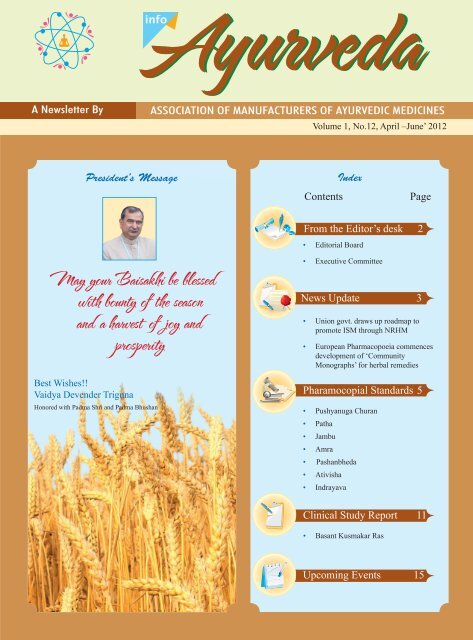

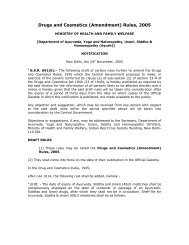
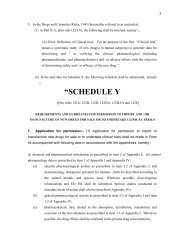
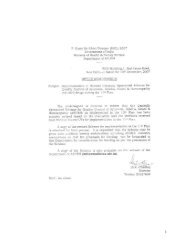

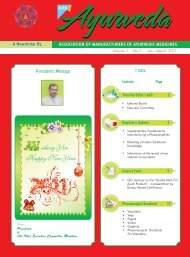

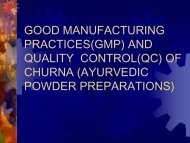
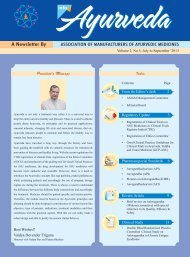
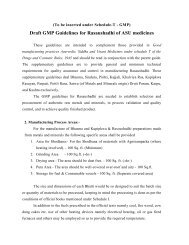
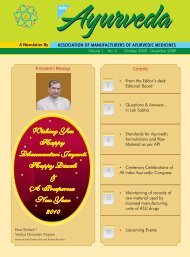
![[To be published in Gazette of India Part II Section 3, sub-section iii]](https://img.yumpu.com/28570283/1/190x245/to-be-published-in-gazette-of-india-part-ii-section-3-sub-section-iii.jpg?quality=85)

